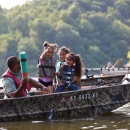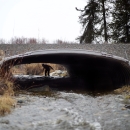States
IdahoThis project will replace a culvert on the South Fork of Running Creek, which will restore fish passage fish passage
Fish passage is the ability of fish or other aquatic species to move freely throughout their life to find food, reproduce, and complete their natural migration cycles. Millions of barriers to fish passage across the country are fragmenting habitat and leading to species declines. The U.S. Fish and Wildlife Service's National Fish Passage Program is working to reconnect watersheds to benefit both wildlife and people.
Learn more about fish passage , improve riparian riparian
Definition of riparian habitat or riparian areas.
Learn more about riparian function, and increase climate resiliency for federally listed Snake River Basin steelhead and bull trout. Removing the passage barrier will open 3.84 miles of designated critical habitat, including 1.5 miles of juvenile rearing habitat. Nearly all the habitat opened up by the project is in pristine condition and located within the Selway-Bitterroot Wilderness. This project will also maintain important road access for the Nez Perce Tribe and local communities.
Project Quick Facts:
| Location | Idaho |
| NFPP Project Funding | $420,000 |
| Restoration Techniques | Culvert Replacement |
| Partner Project Lead | Nez Perce Tribe Department of Fisheries Resources Management Watershed Division |
The National Fish Passage Program combines technical expertise with a track record of success.
Implemented primarily through the Service's Fish and Wildlife Conservation Offices, the National Fish Passage Program provides financial and technical assistance to partners across the country. Since 1999, the program has worked with over 2,000 local communities, Tribes, and private landowners to remove or bypass over 3,400 barriers to fish passage and reopen access to over 61,000 miles of upstream habitat for fish and other animals. Staff have expertise in fish migration and biology as well as financial, engineering, and planning assistance to communities, Tribes, and landowners to help them remove barriers and restore rivers for the benefit both fish and people.
Fish passage project proposals can be initiated by any individual, organization, government, or agency. However, proposals must be submitted and completed in cooperation with a Fish and Wildlife Conservation Office. (Please note that fish passage projects being used for federal or state compensatory mitigation or required by existing federal or state regulatory programs are not eligible for funding through the National Fish Passage Program.)
CONTACT A FISH PASSAGE COORDINATOR IN YOUR AREA TO GET STARTED.



